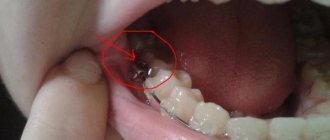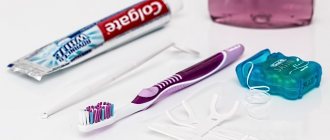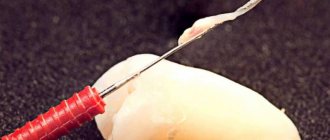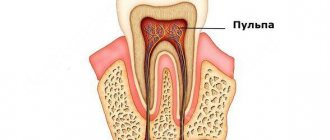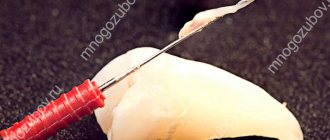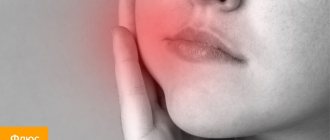Is it possible to remove arsenic or a temporary filling from a tooth on your own at home?
In modern dentistry, arsenic is used quite rarely. However, in some cases, the use of this toxic substance is the only way to cope with toothache. After removing the old filling and placing arsenic paste into the cavity of the diseased tooth, a temporary filling is installed so that the pulp killing agent holds well and does not enter the patient’s body. The dentist extracts the arsenic after a certain time. However, sometimes it becomes necessary to remove it yourself. In this case, you need to follow the rules, otherwise you can only do harm.
Temporary dental filling: all the nuances
After having a filling installed, patients are often interested in when they can eat. It depends on the type of filling. Typically, dentists advise not to eat for an hour or two.
When using dentin paste, it may take about 3 hours to cure, but light-curing cements can tolerate food almost immediately. If you do not want staining of the cement to occur, do not consume food or drinks that are colored.
How long you need to wear a temporary filling depends on the reason for its installation. If a seal was placed to isolate the medication, it will be removed immediately upon completion of treatment. Usually it is placed for a period of one day to one month.
In what cases may it be necessary to independently remove arsenic or a filling?
Arsenic is used when it is necessary to kill the nerve in order to eliminate painful sensations in the tooth. This toxic substance is used in doses sufficient to affect the nerve endings and tissues of the dental system, but safe for the patient’s health if a number of conditions are met. These include:
- exclusion of contraindications to the use of the drug;
- installing a temporary filling over the poison placed in the cavity of the affected tooth;
- strict adherence to the residence time of arsenic in a dental unit.
This toxic substance is highly toxic. If it is not obtained in time, serious complications may develop. Possible consequences of leaving arsenic in the tooth cavity for too long (more than 7 days) include:
- inflammatory processes in soft dental tissues;
- pulp swelling;
- darkening of the enamel;
- drug-induced periodontitis;
- severe damage to the periosteum and bone;
- development of pathological processes in neighboring teeth.
In addition, if the toxic substance is not removed for too long, intoxication of the body can occur.
Sometimes unforeseen situations arise when, for some reason, it is not possible to remove a temporary filling and remove arsenic in a dental clinic. In such cases, the only way out is to remove the toxic substance yourself, and you will first have to pick out the filling material.
In addition to observing the timing of the arsenic paste in the tooth, you should monitor your well-being. If pain occurs, you must immediately remove the substance. After extraction, in any case, you need to see a doctor for further treatment.
When is a temporary filling needed?
When a patient with caries comes to the dentist complaining of tooth pain, it is important for the doctor to assess how deeply the unit is affected and whether the roots and canals are affected. To do this, he sets up a “temporary station” for 2-3 days. If the nerve endings are damaged and a permanent filling is placed, the patient will again experience toothache and will have to have the tooth re-treated. A temporary filling will avoid unnecessary costs and stress.
The dentist decides to install temporary filling material if he diagnoses the patient with:
- deep caries;
- pulpitis;
- periodontitis;
- granuloma;
- tooth cyst;
- abscess.
Such dental manipulation is relevant if it is impossible to treat a tooth in one visit or you need to first relieve the inflammatory process. The doctor also places such a filling while the stump inlays or prostheses are being made in the laboratory.
How to get rid of arsenic?
Before placing arsenic, the old seal is removed and a new one is installed to seal the toxic substance. Since a soft filling material is used in this case, the temporary filling may fall out prematurely. If it is not possible to immediately consult a doctor, the arsenic paste should be removed independently as quickly as possible. Arsenic is removed as follows:
- Teeth are thoroughly cleaned of plaque.
- Hands are washed with soap. Their disinfection with an antiseptic is a mandatory step in preparation for the procedure. For this purpose, you can use any alcohol-containing drink. If you don’t have vodka or alcohol at home, you can use a solution of potassium permanganate.
- Small tweezers or a needle are treated with an antiseptic.
- Using one of the instruments, arsenic is removed from the dental cavity. You need to act as carefully as possible, without violating the integrity of the substance. For convenience, it is recommended to use a mirror. The workplace must be provided with good lighting.
- After the poison is completely eliminated, the oral cavity is rinsed with chamomile decoction, soda solution or an antiseptic.
- A piece of sterile cotton wool or gauze should be placed in the area from which the arsenic was extracted. This measure will avoid contact of food with the dead nerve.
While using arsenic paste, it is not recommended to plan long trips, so that if any painful symptoms occur, you can consult your doctor. Often, teeth that are treated with arsenic are subsequently destroyed, resulting in the need to restore them with a crown.
How to replace an old filling
After diagnosing the condition of the tooth, treatment is prescribed, determined by the depth of the lesion. In case of minor carious process, the old filling is removed using a drill, the resulting cavity is processed and filled again. The health and longevity of the tooth depend on the doctor’s compliance with the technological process:
- cleaning the cavity from carious tissues;
- correct placement of the filling;
- preservation of the anatomical features of the tooth;
- choosing the color of the filling material;
- tight fit.
If the filling is partially damaged, it is not completely removed; filling material is applied to the defect site to restore its shape and tightness.
How to remove a temporary filling?
Patients often remove temporary fillings at home. Experts note that this is not recommended. However, it is better to remove the filling material and arsenic on your own than to delay the time it remains in the tooth cavity. Removing the seal looks like this:
- After brushing your teeth, you should thoroughly wash your hands and treat them with vodka, alcohol or potassium permanganate dissolved in water.
- The needle, tweezers or toothpick are disinfected.
- Looking in the mirror, you need to carefully pry off the filling with a needle, trying not to injure the gum tissue. The instrument should not be inserted too deeply to avoid pain.
- After removing the filling material, the arsenic paste is removed using the method described above.
- As in the previous case, the oral cavity is thoroughly rinsed with chamomile decoction, soda solution or any other means with a disinfecting effect. After this, the resulting depression in the tooth is closed with a piece of sterile cotton wool.
Read also: Wisdom teeth are growing
Don’t be afraid that you won’t be able to pick out the temporary filling. The filling material used in this case has a rather fragile structure, due to which it is easily destroyed under mechanical stress. The video below shows how to properly remove a temporary filling and the arsenic underneath.
Features of installing a temporary filling
Cases when a temporary filling falls out occur quite often. The reasons may be different; to avoid negative consequences, you must follow a number of recommendations and visit a doctor at the first opportunity for re-sealing. If the patient or doctor has doubts about the reliability of fixation of the composition in the tooth cavity, it is better to replace the filling. The temporary filling, as a rule, does not last more than 5 days.
When doubts arise about stability, it is better to reinstall the temporary filling. Sometimes experts dissuade patients from such measures, since the temporary filling contains potent components. If your tooth hurts under the temporary filling for several days after installation, you should tell your dentist about it.
Patients who have any difficulties with visiting the dentist as soon as possible, for example, if a filling falls out in the evening or when an immediate visit to the dentist is unavailable, first of all, it is necessary to exclude the load on the tooth and the penetration of food particles into the coronal cavity. Even if a visit to the dentist is postponed for some time, you should visit him as soon as possible. Otherwise, it will not be possible to avoid complications.
When can you not perform the procedure at home?
Strictly speaking, arsenic paste should only be removed in a dental clinic. Carrying out this manipulation without the participation of a doctor can lead to undesirable consequences. The most likely problems that may arise during the arsenic extraction process include:
- injury to the gums with a needle or tweezers;
- infection in damaged soft tissues;
- violation of the integrity of the extracted piece of paste, as a result of which particles of a toxic substance, together with saliva, enter the gastrointestinal tract and cause various damage to internal organs.
To avoid having to remove arsenic at home, certain rules should be followed. To avoid destruction of the temporary filling, food should be chewed on the healthy side. It is not recommended to plan long trips while arsenic paste is in the tooth. Experts urge patients to treat their recommendations with maximum responsibility; only strict adherence to them will help prevent dangerous consequences.
How to fill a tooth yourself using the Tsivinsky method
It is important to know exactly how and what a filling is made of. As a classic filling, drilling is used, after which a filling is installed. Dr. Tsivinsky has created a new technique that allows the procedure in question to be performed without the use of a drill. This method helps speed up the process of tooth restoration and also eliminates the pain of this event.
The scientist suggested filling the hole in the tooth with the drug Santedex, which is available in powder form. The unknown composition of this mixture was developed by Tsivinsky himself, but this medicine can be purchased at any pharmacy without a medical prescription. The unique medication contains ingredients that adhere tightly to the tooth surface.
Stages of filling with Santedex:
- It is necessary to thoroughly mix the dry and liquid material in the package. The result should be a clay consistency.
- Next, fill the tooth hole with the resulting medicinal mixture.
This procedure is suitable for:
- filling microcracks in the tooth;
- eliminating pain;
- providing a therapeutic effect;
- relieving enamel hypersensitivity.
Filling with Santedex can save a person from the above dental problems overnight. Using this method, you can maintain dental health permanently. The author of the technique speaks about the durability of such fillings, and also emphasizes the need and effectiveness of using medicinal powder for damaged teeth. This is due to the relief of inflammatory processes and disinfection of areas of the oral cavity due to the valuable properties of the medicine.
How to get arsenic out of a tooth yourself
Before dentistry reached a high level of development, arsenic was very often used to remove dental nerves. Nowadays this practice is used very rarely, but has not been completely eliminated. There are cases when the patient, for certain reasons, cannot visit the dentist, but the period of action of arsenic is already quite long and it needs to be removed. In such cases, it is necessary to remove the substance from the tooth cavity yourself, as it is very harmful. You need to know how to remove a filling.
Arsenic in a tooth is usually a blue lump of paste
Possible consequences of an over-inflated filling:
- When the filling is too high, an increased load falls on the tooth; when the mouth is closed, the teeth of the opposite jaw put pressure on the filling. Thus, chronic tooth injury occurs. Constant pressure on the tooth can lead to traumatic pulpitis and periodontitis. As a result, the tooth will need to be depulped.
- With constant increased load on the filling, there is a risk of its chipping, as well as the chipping of the tooth wall.
- If, when closing the mouth, the teeth close together on one side (on an over-inflated filling), but the teeth on the other side do not close, then a kind of “distortion” occurs; the lower jaw may move to the side when closing the mouth. If you tolerate such an inconvenience, your body will eventually get used to it and stop noticing it. However, the problem will remain. The unusual position of the lower jaw when closing the teeth and blocking its lateral displacements can lead to diseases of the temporomandibular joints. Pain, crunching, clicking in the joints of the lower jaw - all this can be a symptom of a disease, which can be caused by over-inflated fillings.
Why is arsenic used in dentistry?
In order to kill the nerve, the dentist can use arsenic in his work. This medication has a necrotic effect on the nerve, which leads to its death. It also has a toxic effect, which requires its short-term use.
In medical practice, the remedy is used to eliminate toothache, which is caused by an open nerve. This can occur as a result of caries, periodontitis, pulpitis and other dental problems.
Arsenic occupies number 33 in the Periodic Table and has another name - arsenum. It is a brittle non-metal substance with toxicity. It has an immunotoxic effect on the human body. A dangerous dosage is 5–50 mg, depending on the individual susceptibility of the body.
The element arsenic is a strong poison
Arsenic in the tooth should not last long.
When performing dental work, the substance falls into the tooth cavity, providing a necrotic effect on the nerve endings and pulp. As a result of this impact, the following processes occur:
- direct cytotoxic effect on cells;
- disruption of cellular respiration and their death;
- denaturation of protein pulp;
- cessation of blood supply to the pulp;
- blocking impulses from nerve endings.
As a result of such processes, the nerve completely dies and becomes insensitive.
The substance is used in the form of a paste, the main component of which is arsenic. As a rule, this is an anhydride: Septodont, Kaustinerv, Pulparsen, Caustitsin, etc.
Arsenic paste for dentistry
The composition of such drugs includes arsenic anhydride, which provides a necrotic effect, as well as a substance that has an anesthetic effect, which allows you to quickly cope with painful sensations. The latter include: novocaine, dicaine, lidocaine.
The components of the paste include substances that ensure the disinfection of dead pulp and the destruction of pathogenic microflora. This may be thymol, carbolic acid and others. Thanks to the astringent components, the diffusion of the main substance is slowed down, as well as the effect of the paste is prolonged.
Regardless of what type of paste is used, it should not remain in the tooth for a long time. Sometimes there are times when you need to get pasta at home. If a person removes a filling, you should try to immediately contact a dentist.
Clarification of symptoms
It is very important to recognize a carious lesion at the earliest possible stage. To do this, you need to clearly know the symptoms and be observant. Paying attention to your body will help you avoid very serious problems in the future.
White spots on teeth are the first signs of pathology
Symptoms of incipient caries may be as follows.
- Light, gently sloping cavities on the teeth.
- Dark depressions or stains on the enamel or between the teeth.
- Increased sensitivity of an individual tooth or the entire dentition.
- Feeling of toothache, even minor.
- Discomfort when eating food of high or low temperature.
- Sensitivity of enamel to sweet, sour, spicy.
- Painful sensations when biting.
Important! Interdental and some other types of deep caries may not manifest themselves for a long time and remain invisible. The disease is detected only with an x-ray, ultrasound, or when the oral cavity is illuminated with a fluorescent lamp. That is why visiting the dentist twice a year is a guarantee of early detection of carious symptoms and successful treatment of the disease.
Interdental caries
Having identified one or more symptoms of caries, you should immediately make an appointment with a doctor, without waiting until the due date has expired and it is time for the next preventative visit.
At the appointment, the doctor must tell you about the symptoms and point out any signs of destruction found. The dentist examines the oral cavity using instruments to identify tissue softening (light carious spots) or darkening. Depending on the stage of the disease, the doctor will recommend a home treatment algorithm or use one of the clinical methods for eliminating caries.
There is no need to wait until caries completely destroys your teeth; it is better to contact your dentist on time
How long should arsenic remain in a tooth?
Installing arsenic takes a little time. The dentist performs the following actions:
- pulp opening;
- removal of damaged dentin;
- laying the paste;
- providing sealing using artificial dentin.
Previously, the substance was placed with a closed pulp, but now this practice is not used, as there is a possibility of pain and swelling. Arsenic, depending on which tooth is being treated, is set for the following period of time:
- single-rooted – 24 hours;
- the rest – 48 hours.
It is very important to visit a doctor on the day of your appointment, as prolonged exposure to the substance becomes dangerous.
Read also: Arsenic in dentistry
A temporary filling over arsenic has fallen out - you need to see a doctor urgently
Arsenic should not be kept for more than 62 hours.
There are substances that can be kept for up to two weeks, these include depulpin. It is necessary to clarify with a specialist which particular drug was used. If it is not possible to visit the dentist at the appointed time, you need to extract the substance yourself. You need to be very careful with arsenic so that it does not enter the gastrointestinal tract when extracted. You need to remove it yourself for certain reasons.
Why might you need to extract arsenic yourself?
Arsenic paste has a high toxicity rate. It needs to be taken out in time. If it remains in the tooth for more than a week, inflammation of the soft dental tissues and other negative processes develop, which include:
- swelling of the pulp;
- darkening of dentin;
- drug-induced periodontitis;
- death of the periosteum and bone;
- necrotic effect on adjacent teeth.
It is necessary to keep the substance for the prescribed time and not violate the terms of its withdrawal. Just in case, you need to know how to remove arsenic from a tooth yourself. With prolonged exposure to the paste, complete intoxication of the body can occur. And also negative phenomena can occur with an incorrectly calculated dose.
Due to such a high risk of adverse reactions, the drug is used very rarely, although it used to be quite common.
The patient should be attentive to the timing of use of arsenic paste and do not forget to visit a doctor. You need to know when to get the pasta. Despite its necrotic and analgesic effect, the substance located in the tooth can cause pain, which also requires its immediate removal.
A tooth with arsenic hurts - it needs to be removed
The causes of pain are the following:
- the substance does not kill nerve endings, since it is not concentrated enough;
- long duration of action of certain drugs;
- inflammation of tooth tissue;
- necrosis in the area of the periosteum or jawbone;
- substance intolerance;
- incorrectly inserted paste.
Any of these reasons causes pain, which should alert the patient and remove the substance. You need to immediately consult a doctor or, at first, get the paste yourself. When a person removes a substance himself, he must understand that subsequent treatment cannot be avoided.
How to extract the substance yourself?
After the doctor places the arsenic paste, a filling is placed on top, which prevents it from falling out of the tooth cavity. Sometimes it falls out on its own, which requires immediate attention to the dentist.
Removing arsenic paste yourself is dangerous. In addition, if you open the filling, the pain may only intensify. If the pain has stopped and the prescribed period of wearing the substance has expired, you can still try to remove it, if it is not possible to visit a specialist. There are certain steps that need to be taken.
- Brush your teeth well.
- Wash your hands with soap and treat with an antiseptic.
- Prepare a tool: a syringe or sewing needle, thin tweezers, and a toothpick will do. The item must be treated with an antiseptic. You can use alcohol, vodka, and potassium permanganate solution.
- Stand in front of the mirror and lightly pick up the filling without touching the gums. Do not insert the needle too deeply, as this may cause pain.
- After removing the filling, you need to try to get the substance out so that it does not crumble in the oral cavity.
- After completely cleaning the tooth from the drug, you need to rinse your mouth with an antiseptic or chamomile infusion.
A visit to the dentist for dental cleaning and treatment is mandatory.
Many people ask: if I remove the substance itself, what will happen. Nothing fatal will happen, but further treatment cannot be avoided. After arsenic has been removed, you should consult a doctor as soon as possible, since during the period of its action, the walls of the tooth have become thin, like its other parts, which can lead to its rapid destruction.
It is recommended not to plan long trips if arsenic has been detected, so that at the first appearance of negative symptoms you can consult a specialist. And it is also better to choose a method of treating dental nerves that does not use such a substance.
Very often, teeth that are treated with arsenic paste quickly crumble, which requires the installation of a crown.
Removing arsenic is very simple, but the consequences after it are very costly and long-lasting. You need to constantly visit the dentist to avoid moments when the tooth can no longer be saved except with the help of arsenic paste. It is recommended to use a good toothpaste that protects against caries.
Prevention of temporary filling falling out
After the performed manipulations, the doctor always tells the patient what can and cannot be done after he leaves the office. And you need to follow these recommendations.
- You should not eat for 2 hours after filling. At this time, the material hardens.
- During the entire period while the temporary filling is in place, you must not chew nuts and other hard foods, eat chewing candies and other sticky sweets, or use chewing gum.
- It is recommended to minimize the load on the problematic tooth.
- Do not use a waterpik, toothpicks or dental floss to clean a temporary filling. The optimal hygiene product is a soft brush.
It is recommended to inspect the filling daily so that if defects appear, you can detect them in a timely manner and contact your dentist.
Why is arsenic needed in dental treatment?
The limit varies from 5 to 50 mg depending on the weight parameters and sensitivity of the patient. Nowadays they use not arsenic, but a paste based on it containing:
- 1/3 of the paste is arsenic anhydride;
- less than 1/3 of the composition is a substance for accelerated pain relief;
- 5% camphor or thymol to eliminate microflora and sterility of the pulp;
- only 1% tannin - to extend the effect of the drug to 2 days, since this substance can slow down the process of diffusion of arsenic into the pulp tissue.
Read also: Removal of tooth nerve during pregnancy
Indications and contraindications for use
The drug is used when it is necessary to remove a nerve and to prevent further pain during therapy.
A small dose of arsenic in the tooth and the required exposure for a certain time cannot harm the patient. Before starting any treatment procedure, the dentist must make sure that the patient has no contraindications for a specific therapy. There are not many of them, but a competent doctor should take into account all the points when using arsenic paste in each individual case. The drug is not applicable if:
- diseases associated with the genitourinary system;
- individual intolerance to any component of the paste containing arsenic;
- child under two years of age, during pregnancy or breastfeeding;
- restrictions on accessibility to the dental canal, and when it is impossible to apply arsenic topically.
Signs that a filling is about to fall out
The first symptoms of impending filling loss may be discomfort during chewing - an unpleasant feeling of “sand on the teeth.” Microgaps between the filling compound and the tooth accumulate food debris, which also causes discomfort. If you have the opportunity to examine the tooth yourself, then, as a rule, you will notice that the filling has begun to partially collapse. The gaps between the tooth and the filling gradually widen, and the filling begins to wobble, which is clearly felt by the tongue if you press the filling with it.
What to do if a tooth hurts after filling?
There is no need to endure pain symptoms under a filled tooth. At home, you can temporarily use regular pharmaceutical products. However, if this does not help, especially at night, you should immediately go to the doctor and take out the paste. Sometimes the pain increases to an unbearable degree. This is possible in the following cases:
- insufficient dosage or the presence of a high threshold of sensitivity to the drug in a person;
- the duration of the period of exposure of the substance to the nerve, when the pain subsides only by the third day;
- the drug inflames the soft tissue, which is accompanied by swelling, and the temperature may rise; you should urgently consult a doctor and get the paste;
- the occurrence of inflammation in any part of the tooth is a serious problem that requires long-term and expensive treatment;
- if you are intolerant to one of the components of the paste or arsenic, when allergic swelling or other dangerous reactions occur, for example, a shock effect, if symptoms increase, immediately call an ambulance;
- incorrect installation of the drug.
